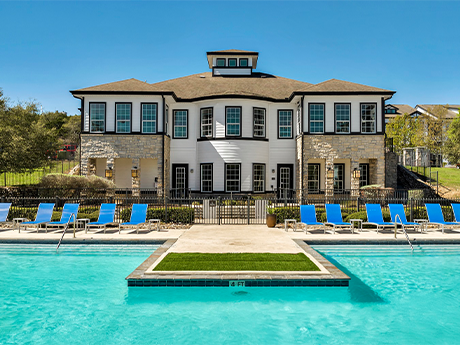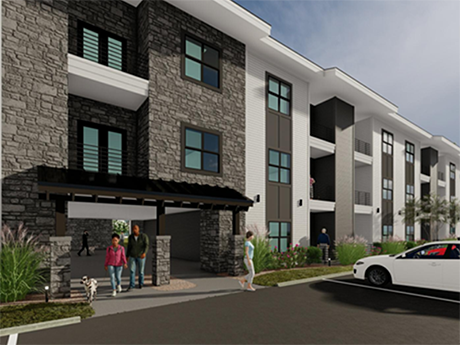The apartment market in San Antonio today is a mixed bag. Like most Sun Belt metros, supply exceeds demand in Alamo City. While property managers are struggling to lease up their communities, investors are sitting on the sidelines until interest rates stabilize and the market starts absorbing units developed during the post-COVID building boom.
On the plus side, population growth, a metric apartment investors prize because it feeds renter demand, is solid in San Antonio. In May, the U.S. Census Bureau ranked San Antonio the third fastest-growing city in the nation. In the city of San Antonio, population grew by 18,889 new residents between 2021 and 2022, for a total citywide population of 1.5 million.
According to Fannie Mae’s Metro Housing Outlook report for San Antonio, which was published earlier this year, in-migration for the entire metro area has averaged more than 28,000 residents per year for the past four years. The population is projected to grow at twice the national rate, the report states, and even faster in the 20- to 34-year-old prime renting cohort.
While current conditions are less than ideal, the future still looks bright. Experts predict solid renter demand and economic growth will smooth out the rough edges that landlords and investors are currently experiencing.
New Supply Dents Occupancy
According to MRI ApartmentData, San Antonio is experiencing one of its lowest occupancy rates in the past decade. As of this October, occupancy was hovering at 88 percent compared with approximately 94 percent one year earlier.
Most agree the drop in occupancy is due primarily to new supply hitting the market. The number of units under construction is high, but experts say the escalating costs to build will likely prevent developers from breaking ground on a fair share of planned projects.
Per MRI ApartmentData, 1,854 units were absorbed between the third quarter of 2022 and third quarter of 2023. Currently, developers are constructing 16,774 units. MRI ApartmentData also reports that rents decreased by 0.6 percent between the third quarter of 2022 and the third quarter of this year.
“One of the factors dampening rent growth is the construction pipeline,” says Ben Fuller, managing director with Cushman & Wakefield’s Sunbelt Multifamily Advisory Group, a 110-person investment sales team covering 11 states. Fuller is based in Austin, Texas.
“San Antonio is in a state of adjustment as it adapts to the ongoing influx of new rental units. The development pipeline (which includes units both planned and underway) currently possesses north of 22,000 units, or approximately 12 percent of existing inventory. While this figure is significant, it has likely peaked as rising construction costs and tightening credit conditions impact the feasibility of new projects coming to fruition.”
San Antonians Seek SFRs, Affordability
Renter demand in San Antonio favors affordable housing and single-family rentals (SFRs). Yardi Matrix reports that rents are growing faster among SFRs compared with conventional apartments. Monthly rents for SFRs increased 6.7 percent in the first quarter of 2023 compared with the same period a year earlier.

An SFR is a single-family home that is rented out, while build-to-rent (BTR) communities are an emerging multifamily asset class that is capitalizing on the popularity of renters opting for houses over conventional apartment communities. BTR communities typically offer standalone homes, duplexes or townhomes for rent that include amenity packages and management and maintenance services found at apartment communities.
Frame Med Center is a new BTR property that AHV Communities recently opened in San Antonio. The project’s starting rents are higher than local, comparable rental homes.
Asking rents at the 174-unit, duplex-style community start at $2,250, substantially higher than the metro’s average asking third-quarter rent of $1,304, per RentCafe. But Mark Wolf, founder and CEO of AHV Communities, believes renters are ready to pay.
“For this cost, you get a high-quality, well-designed house with smart home technology, a private, fenced backyard, a two-car garage, amenities such as a resort-style pool, dog park and fitness center and onsite property management,” says Wolf.
Wolf explains that Frame is centrally located to major employers and interstates. He says area renters can afford to pay more than the local average monthly rental rate. The property is located about oneand-a-half miles from the South Texas Medical Center, an area in northwest San Antonio known simply as Medical Center.
“For Frame specifically, the growth of the healthcare and education industries will assist with long-term leasing and demand. With development of parks, trails and other community amenities, we aim to be here for the long haul,” says Wolf.
From the renter’s perspective, San Antonio is the most affordable Texas metro. Fuller explains that Houston, the next most-affordable apartment market, averages about $62 higher in asking rents per unit. “Given San Antonio’s current cheaper average rent and larger percentage of supply delivering, San Antonio will likely remain the cheaper option in the near-term future,” says Fuller.
According to Fannie Mae’s San Antonio housing report, per capita income in the metro is 21 percent below the national average, “which means that demand is primarily for affordable product,” the report states.
Indeed, pricier communities are having a harder time leasing up. Almost half of the metro’s Class A properties are currently offering concessions to both new tenants and those renewing their leases.
According to MRI Apartment Data’s Market Line Report, released this October, 45 percent of Class A units are providing incentives that include giving away a month or so of free rent or upgrading floor plans for renters who renew their leases. Comparatively, concessions are being offered at 34 percent of the metro’s Class B properties, 33 percent of Class C properties, and 20 percent at the area’s Class D communities.
Investors Pursue Value-Add Deals
Some investors opt to chase renter demand in the middle-market segment of the population. The Milestone Group, for example, recently completed a value-add acquisition in the Encino Hills neighborhood, adjacent to the Far North Central neighborhood and located about 20 miles north of downtown San Antonio. The property, called Archer Stone Canyon, consists of 228 units and offers amenities such as a resort-style pool, a 24-hour fitness center, a clubhouse and a playground.
The Dallas-based investment firm seeks value-add opportunities. While each project is unique, Vice President of Acquisitions Jim Duey explains that the common theme is always to implement a complete capital improvement plan that addresses all elements of the living experience and not just the unit interiors. Milestone typically holds assets for five to seven years.
“Archer Stone is the right fit for Milestone because we believe the larger unit size, low-density rental product will be in the most demand in the future,” says Duey. “And for a variety of reasons, including escalating construction costs, the limited amount of new construction in the immediate trade area is focusing on higher-density, smaller-unit, one-bedroom product.”
Transaction volume has been slow. Yardi Matrix reports $176 million in multifamily investments in the greater San Antonio area during the first quarter compared with $822 million during the same period a year earlier, a decline of approximately 79 percent. Value-add investments, in both heavy-trade climates as well as in slower years, tend to pique the interest of investors.
According to Marcus & Millichap, nonlocally based investors completed bulk or portfolio sales in suburban submarkets like Northwest and Far West. Many of these properties were pre-2000 Class B or C assets with more than 200 units, purchased by out-of-state buyers, according to the firm’s third-quarter 2023 market report.
Mapping Future Renter Demand
In addition to the Far North neighborhoods, the metro is home to several areas that are expected to attract future investment. Northeast of downtown, New Braunfels rests along the route to Austin. According to San Antonio-based Cody Courtney, a senior director with Berkadia, the city is expected to be one of the epicenters of future renter demand.

“New Braunfels is an excellent market to keep an eye on,” he says. “With a straight shot up I-35 to Austin, New Braunfels serves as the next major node of the Texas Triangle. We’re also seeing an expansion into the neighboring Universal City and Seguin markets.” The Texas Triangle is the region, or mega-region as most refer to it, made up of Dallas-Fort Worth, Houston, San Antonio and Austin.
However, Courtney explains that the growth in New Braunfels continues to be dwarfed by the Far West, Northwest and North Central submarkets. “Each of these have over 130 operating properties and are in the strike zone for pipeline completion,” he says. “All signs are pointed in the best direction for the northern markets; however, the southern half of San Antonio should not be overlooked.”
Brooks, for example, is a 1,308-acre mixed-use community in Southeast San Antonio that was built in 2001 as a redevelopment of Brooks Air Force Base, which ultimately ceased operations in 2011. According to the property website, the site still contains 250 acres of developable land. Courtney says growth at Brooks, as well as at Texas A&M San Antonio and automobile manufacturers, including Toyota and DeLorean, are drawing San Antonio’s established southern work force.
Courtney explains that, historically, the city grew out in a northwest direction due to cooling wind patterns prior to the invention of air conditioning, and these areas continue to be targets for developers. Today, employment and education, not cool breezes, bring renters. The University of Texas at San Antonio (UTSA), for example, received a Carnegie Tier 1 research designation in 2021, which is the highest ranking for doctoral-granting institutions and indicates a high level of research and development.
Based on rent growth and absorption between August and October 2023, the top five San Antonio submarkets, per MRI ApartmentData are Port San Antonio/ I-35S; Leon Springs/ Boerne/ Kerrville; Castle Hills/ San Pedro/ Jackson-Keller; Nacogdoches Road/ Perrin Beitel Road; and New Braunfels/ Seguin.
Adjacent to UTSA are two large retail destinations, The Shops at La Cantera, with 1.3 million square feet of retail space, and The Rim with 1.8 million square feet of retail. The North Central submarket is also home to the San Antonio International Airport. This year, the airport began an expansion project to add a new terminal, renovate the existing Terminal A and upgrade and improve the airfield and roadways. The project, estimated to cost $2.5 billion, is expected to be complete in 2050.
“In 2019, the airport recorded 10 million passengers and projections see this number continuing to grow aggressively over the next 20 years,” says Courtney.
He adds that in addition to the airport, master-planned communities are also expanding in San Antonio.
“Initiatives like Brooks City Base and Port San Antonio are uniting pre-existing military structure with new urban ideologies,” says Courtney. “Brooks City Base itself offers tax-free land, Opportunity Zone designation and build-to- suit opportunities for multifamily and commercial developers under its established design and development standards. Additionally, Port San Antonio houses leading firms within the aero- space, defense, global logistics, cybersecurity and education industries. Together, they generate over $5 billion in annual economic activity for the region.”
OKIN Process, a Czech Republic-based business supplier, recently selected Brooks as its U.S. headquarters. Nissei America Inc., a plastics manufacturer based in Japan, also moved its U.S. headquarters to Brooks in 2021.
“The greatest thing about Texas, and thus San Antonio, is the state itself is often the last one into economic decline and the first one out,” says Courtney. “Thanks to development-focused policies within the state and city, our housing stock continues to grow. On average, our multifamily housing was built in 1996. With such a vintage, the market remains primed for value-add investors seeking to capture renovation premiums.”
— By Lynn Peisner. This article originally appeared in the Sept/Oct issue of Texas Multifamily & Affordable Housing Business.


